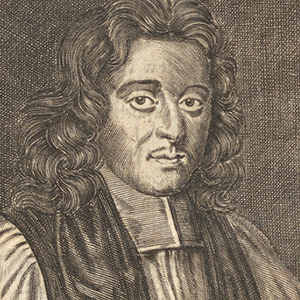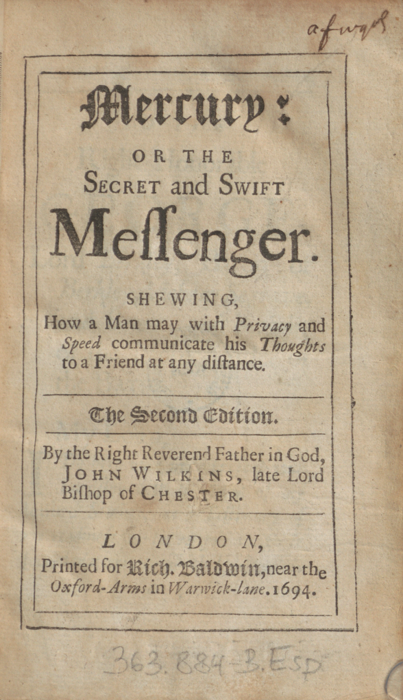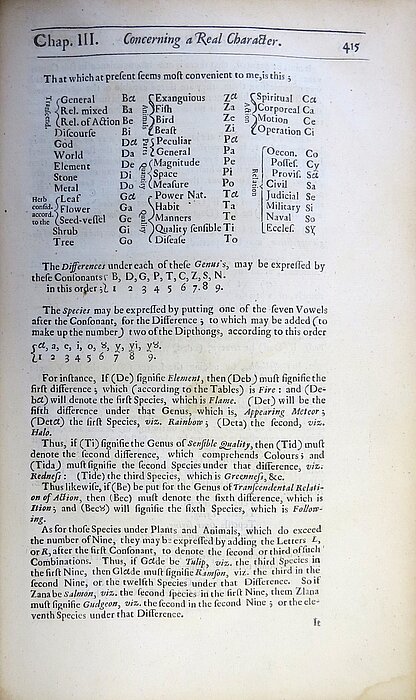Aufgrund einer polizeilichen Platzsperre des Josefsplatzes öffnet der Prunksaal am Dienstag, 21. Oktober, erst um 12 Uhr.
Der Augustinerlesesaal öffnet an diesem Tag erst um 12.30 Uhr.
Der Lesesaal der Kartensammlung öffnet an diesem Tag erst um 12 Uhr.
Aufgrund einer Veranstaltung öffnet der Prunksaal am Mittwoch, 22. Oktober 2025 erst um 12 Uhr.
Der Augustinerlesesaal bleibt an diesem Tag geschlossen. Der Lesebetrieb wird in den Studienlesesaal der Sammlung von Handschriften und alten Drucken ausgelagert.
Aufgrund einer Veranstaltung bleibt der Prunksaal am Freitag, 31. Oktober ab 15 Uhr geschlossen.
Die Lesesäle am Heldenplatz bleiben am Sonntag, 26. Oktober (Nationalfeiertag), Samstag, 1. November (Allerheiligen) und Sonntag, 2. November 2025 (Allerseelen) geschlossen.
In Prunksaal, Literatur-, Papyrus-, Globen- und Esperantomuseum gelten die regulären Öffnungszeiten.
John Wilkins‘s artificial language
Forschung

350 years ago, the most important contribution to the artificial language movement of the 17th century, John Wilkins‘s Essay Towards a Real Character and a Philosophical Language, was published.
Author: C. Naomi Osorio-Kupferblum
John Wilkins had a point. If you think about it, natural languages are really not well suited for their task of facilitating communication. Where we need them most – for communicating across space or time – is also where one of their greatest weaknesses lies: the greater the distance, the greater the differences in grammar and vocabulary and therefore also the greater the difficulties in understanding each other. But the trouble doesn’t end there: We often use the same word to mean different things and several words to mean the same thing. Polysemy and synonymy are therefore additional factors contributing to the imperfection of natural languages (Wilkins 1668: 17 f.). Born in 1614 (Davies 2004), four years before the Thirty Years’ War broke out, Wilkins was well aware of the full impact of this obscurity and ambiguities, and of the possibility of intentional manipulation they generate. The root of the problem, Wilkins thought, lies in the fact that there is no intrinsic connection between a word, say, ‘horse’ or ‘tree’, and what it stands for – the animal or the plant. The situation is even worse for written language. Letters bear no relation whatsoever to the sounds they represent and even less to the meaning of the words we compose out of them (Wilkins 1668: 14 ff.).
Wilkins had already studied the written transmission of language in his 1641 book Mercury, or the Secret and Swift Messenger, a collection of secret languages and codes, on display in the Austrian National Library’s Esperanto Museum. In 1647, Wilkins became Warden of Wadham College, Oxford (Davies 2004).
He gathered around him a group of ‘natural philosophers‘ who carried out research and experiments according to Bacon’s empirical method. Among the eminent members of this Oxford Philosophical Club, a precursor of the Royal Society, were the mathematician Seth Ward, physician Thomas Willis, architect Christopher Wren, chemist Robert Boyle and polymath Robert Hooke.
In those days, a time of inventions and discoveries, the circle of people to communicate with expanded rapidly. However, neither the craftsmen who made their instruments and devices, nor the inhabitants of faraway lands which Europe had discovered, invaded and colonised, understood the scholarly lingua franca, Latin. Developing a language that would be understood around the globe was therefore a natural idea. At the centre of the 17th century’s artificial language movement was the so-called Hartlib Circle. One of Samuel Hartlib’s protégés, the school master George Dalgarno, proposed establishing a direct connection between words and what they stand for. He turned to Wilkins for scientific assistance. Wilkins was immediately interested. However, they could not agree on the approach to take (Lewis 2007: 88), and in the end, each designed his own language. Dalgarno’s project was more modest, but he later gained recognition for a language for the deaf. Wilkins‘s Essay Towards a Real Character and a Philosophical Language, by contrast, became his magnum opus.
The idea was as brilliant as it was simple, even if its realisation would then be highly complex. It is obvious to everyone, no matter which language they speak or how and where in the world they live, that a horse is not a tree and a tree is not water. The world simply consists of things, properties and events that are inherently different and can therefore be categorised naturally – such was the underlying, Aristotelian, idea (Wilkins 1668: 20). But if the entire universe and everything in it could be ‘enumerated and described’ in a kind of Porphyrian tree, all that would be needed was a way of pointing to the individual places in the scheme in order to have a scientifically precise means of communication, without ambiguities and therefore also without the danger of misleading representations. Words would then not express what a speaker has in mind, but instead refer directly to what they stand for – in a way not dissimilar to geodata, which unambiguously indicate a specific place.
With the help of Seth Ward, Francis Willoughby, John Wray, William Lloyd and others (Wilkins 1668: Epistle to the Reader), Wilkins therefore compiled a catalogue of everything in the universe. Created decades before Linnaeus and the encyclopédistes, this fascinating taxonomic system contains hundreds of entries with short definitions, assigned to 40 genera, each with up to 9 differences and species.
The characters, which look a bit like shorthand, have little strokes and loops to point to specific places in the system and consequently to a specific thing or property. Thus ‘horse’ (Wilkins 1668: 156) can be found under
V. BEASTS
I. WHOLE FOOTED BEASTS
1. HORSE
next to: 2. ‘ASSE’ and ‘MULE’.
These characters therefore do not represent sounds but the things themselves because by pointing to a place in the taxonomical system, they indicate the essential properties of the item referred to. In order to be able to use the language not only in writing but also in oral communication, syllables are assigned to each genus, stroke and loop. Horse, for instance, becomes ‘ZiBα’.
Wilkins thereby not only established a direct relation between the signifying character and the signified item, he also turned around the relation between signs and sounds. Instead of representing sounds by signs, he made signs effable and thus audible.
The last part of this grand oeuvre is Lloyd’s alphabetical dictionary, which indicates the relevant place in the system and is indispensable to the learner.
In addition, this 600-page book contains Wilkins’s thoughts about phonetics and grammar, and even a drawing of Noah’s Ark, proving that it had enough space to store food for all the animals.
Wilkins’s language has a number of advantages. First, it is as precise as the taxonomical system on which it is based. Ambiguities are ruled out. Second, it only changes when further items (for instance, new inventions) are integrated into the taxonomy. Otherwise, words remain the same across space and time. Third, the greatest source of error, i.e. speakers, are given only minimal influence on the language. Instead of determining the meaning of words by convention, people only record what is given in nature – and that task can be assigned to experts. The only element that is conventional is the choice of written symbols and of syllables, neither of which has an impact on meaning. Fourth, the language advances knowledge. Words are intrinsically meaningful. So, when I read or hear a word, I know to which place in the ‘tree’ it refers and therefore what the essential properties of the signified item are. Conversely, I can deduce the name of a thing if I know its essential properties. The precision and constancy of this language is an asset to science, and it also protects people from being intentionally misled by ambiguities, imprecisions or partial truths.
These objectives take Wilkins‘s language far beyond the considerations on which other artificial languages are based. It is therefore not only of historical but also of current philosophical interest.
But the impressive project ran out of luck early on. The book had gone to press when the Great Fire of London broke out in 1666. In addition to the many precious pages already printed, the manuscript itself went up in flames. When the Essay Towards a Real Character and a Philosophical Language with its 454 pages + 155-page dictionary was finally published in 1668, Wilkins explained in the Epistle Dedicatory that the Essay was to be regarded as a first proposal and that the project needed more work. The aim was to disseminate the language around the world (Wilkins 1668: Epistle Dedicatory). But Wilkins died only four years after its publication and left his ‘darling’ orphaned. In spite of a Royal Society committee’s (intermittent) efforts to continue the project (Lewis 2001), and the fact that it continued to meet with the interest of the “men of great learning” (Wilkins 1668: Epistle Dedicatory) to whom it was to be sent (it inspired Leibniz and was recommended in correspondence by Locke (Locke 1681, 1976-89), but criticised in his Essay Concerning Human Understanding (Locke 1689/90, 1975: 509, III.xi.2), it lacked the commitment and enthusiasm that would have been necessary to teach and spread the language. To this day, this historically greatest project of a universal as well as scientific language remains of only theoretical importance.
About the author: Dr C. Naomi Osorio-Kupferblum is simultaneous interpreter and philosopher.
Literature quoted and recommended for further reading
Cram, David / Maat, Jaap (eds.) (2001): George Dalgarno on Universal Language: 'The Art of Signs'(1661), 'The Deaf and Dumb Man's Tutor'(1680), and the Unpublished Papers, Oxford: Oxford University Press.
Davies, Cliff S.L. (2004): The Family and Connections of John Wilkins, 1614–72, in: Oxoniensia, LXIX, pp. 93-108.
Funke, Otto (1929): Zum Weltsprachenproblem in England im 17. Jh. G. Dalgarno's Ars Signorum (1661) und J. Wilkins Essay Towards a Real Character and a Philosophical Language (1688), in: Anglistische Forschungen, 69.
Leibniz, Gottfried Wilhelm (1923-): De Lingua Philosophica, in: Deutsche Akademie der Wissenschaften (ed.), Sämtliche Schriften und Briefe, Berlin: Akademie Verlag, series VI, vol. 4, N.186.
Lewis, Rhodri (2001): The efforts of the Aubrey correspondence group to revise John Wilkins’ Essay (1668) and their context, in: Historiographia linguistica 28.3, pp. 331-364.
Lewis, Rhodri (2007): Language, Mind and Nature: Artificial Languages in England from Bacon to Locke, Cambridge: Cambridge University Press.
Locke, John (1681, 1976-89): Letter no. 656 to Nicolas Toinard (16 August 1681) in: de Beer, E.S. (ed.) (1976-1989), The Correspondence of John Locke, Vol. II, Oxford: Clarendon Press.
Locke, John (1689/90, 1975): An Essay Concerning Human Understanding, Nidditch P. H. (ed.), Oxford: Oxford University Press.
Maat, Jaap (2004): Philosophical Languages in the Seventeenth Century: Dalgarno, Wilkins, Leibniz, Dordrecht i.a.: Kluwer Academic.
Pombo, Olga (1987): Leibniz and the Problem of a Universal Language. Münster: Nodus-Publ.
Shapiro, Barbara (1969): John Wilkins, 1614-1672 : An intellectual biography. Berkeley i.a.: University of California Press.
Subbiondo, Joseph L. (1992): John Wilkins and 17th-Century British Linguistics, Amsterdam i.a.: Benjamins.
Wilkins, John (1668): An Essay Towards a Real Character and a Philosophical Language, London: Gellibrand.
Wilkins, John (1694): Mercury: Or The Secret And Swift Messenger. Shewing, How a Man may with Privacy and Speed communicate his Thoughts to a Friend at any distance, (The Second Edition), London: Printed for Rich. Baldwin.
[1] Works by Thomas Willis, Robert Boyle and Robert Hooke are kept in the Department of Manuscripts and Rare Books of the Austrian National Library.
[2] Lewis, Rhodri (2007): Language, mind and nature: Artificial languages in England from Bacon to Locke. Cambridge: Cambridge University Press, provides an excellent history of the movement.
[3] Leibniz mentions Wilkins’s Essay in ‘De lingua philosophica’ (written between 1677 and 1687), for instance.





